

Japan to greatly extend range of Type 12 anti-ship missiles, modify it for F-15J
On december 18, 2020, the japanese government decided to extend the range of type 12 surface-to-ship missiles (ssm) manufactured by mitsubishi heavy industries. what's more: the missile could be modified into an air-launched variant for the f-15j fighters..
Yoshihiro Inaba 21 Jan 2021
Originally, an extended-range version of the Type 12 SSM was under development and was scheduled to be developed over a five-year period starting in FY2017. This range extension basically did not change the basic character of the Type 12 SSM in any significant way. However, the one decided on this time is different from that.
Significant range increase
According to documents released by the Ministry of Defense (MoD), the increased range will be achieved by extending the size of the wings and the altitude at which the jet engines can operate. In other words, the Type 12 SSM will be able to fly at a higher altitude than before. According to the Sankei Shimbun and Mainichi Shimbun , two of Japan’s major media outlets, these improvements will significantly extend the range of the Type 12 SSM from 200 km to 900 km, with the goal of reaching 1,500 km in the future.
Furthermore, the Type 12 SSM did not adopt the same shape as the NSM and LRASM to ensure stealth performance. However, this modification will reduce the Radar Cross-Section (RCS) to ensure such stealth performance. As a result, its appearance will be completely different from the current one. Also, according to the MoD document mentioned earlier, the improved Type 12 SSM will be able to attack not only enemy naval vessels but also ground targets. In addition, the missiles will be updated with data about their targets via satellite communications during their flight, which will improve the accuracy of their attacks.
New SSM for Island Defense by Kawasaki Heavy Industries

The improvement of Type 12 SSM will be done in the period from FY2021 to FY2025. In order to realize this work in such a short period of time, the results of research on the new SSM for island defense (manufactured by Kawasaki Heavy Industries), which is currently under development, will be reflected. This new SSM is scheduled to be developed from FY2019 to FY2023, and according to Sankei Shimbun, its range is targeted at 2,000 km.
Type 12 SSM for F-15J and surface combatants ?
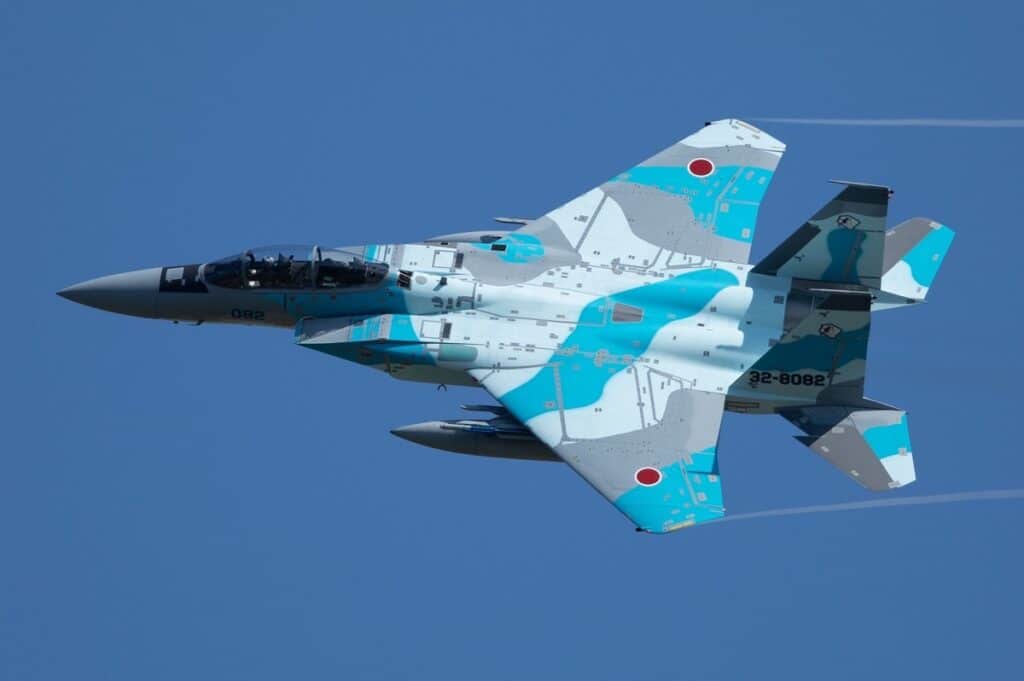
This improvement of the Type 12 SSM is noteworthy for its relationship with the upgrade of the Japan Air Self-Defense Force (JASDF) to equip its F-15J fighter jets with long-range missiles. The Japanese government had planned to upgrade some of the F-15Js operated by the JASDF to replace their radar and electronic warfare equipment with the latest ones, and to enable them to carry JASSM-ER and LRASM. However, due to the higher-than-expected cost of the upgrade, it was not included in the FY2021 defense budget request. The original plan was to complete the upgrade of 20 F-15Js by FY2027, but that schedule is expected to be significantly delayed.
Under such circumstances, the improvement of the Type 12 SSM suddenly emerged, and the fact that its range will be increased to 900 km (similar to that of the JASSM-ER and LRASM) cannot be considered a mere coincidence. In addition, the MoD is looking to launch the modified Type 12 SSM not only from ground, but also from naval vessels and aircraft. In other words, the Type 12 SSM may be developed into an air-launched variant with the goal to integrate it on the F-15J.
Operational concept of the modified Type 12 SSM:

Source: Japanese MoD.

Related Articles

New Zealand P-8A to Make Inaugural Deployment to Japan
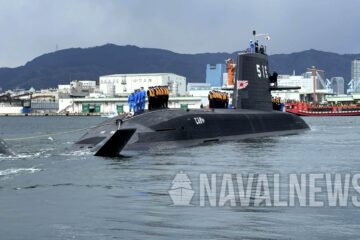
Japan Commissions Third Taigei-class Submarine
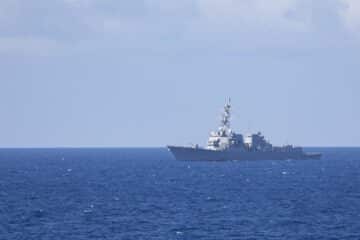
US Navy Destroyer not allowed to enter Japanese Port
- Subscribe Digital Print

- LDP funds scandal
- Latest News
- Deep Dive Podcast
Today's print edition
Home Delivery
- Crime & Legal
- Science & Health
- More sports
- CLIMATE CHANGE
- SUSTAINABILITY
- EARTH SCIENCE
- Food & Drink
- Style & Design
- TV & Streaming
- Entertainment news
With eye on China, Japan developing missiles to protect remote islands
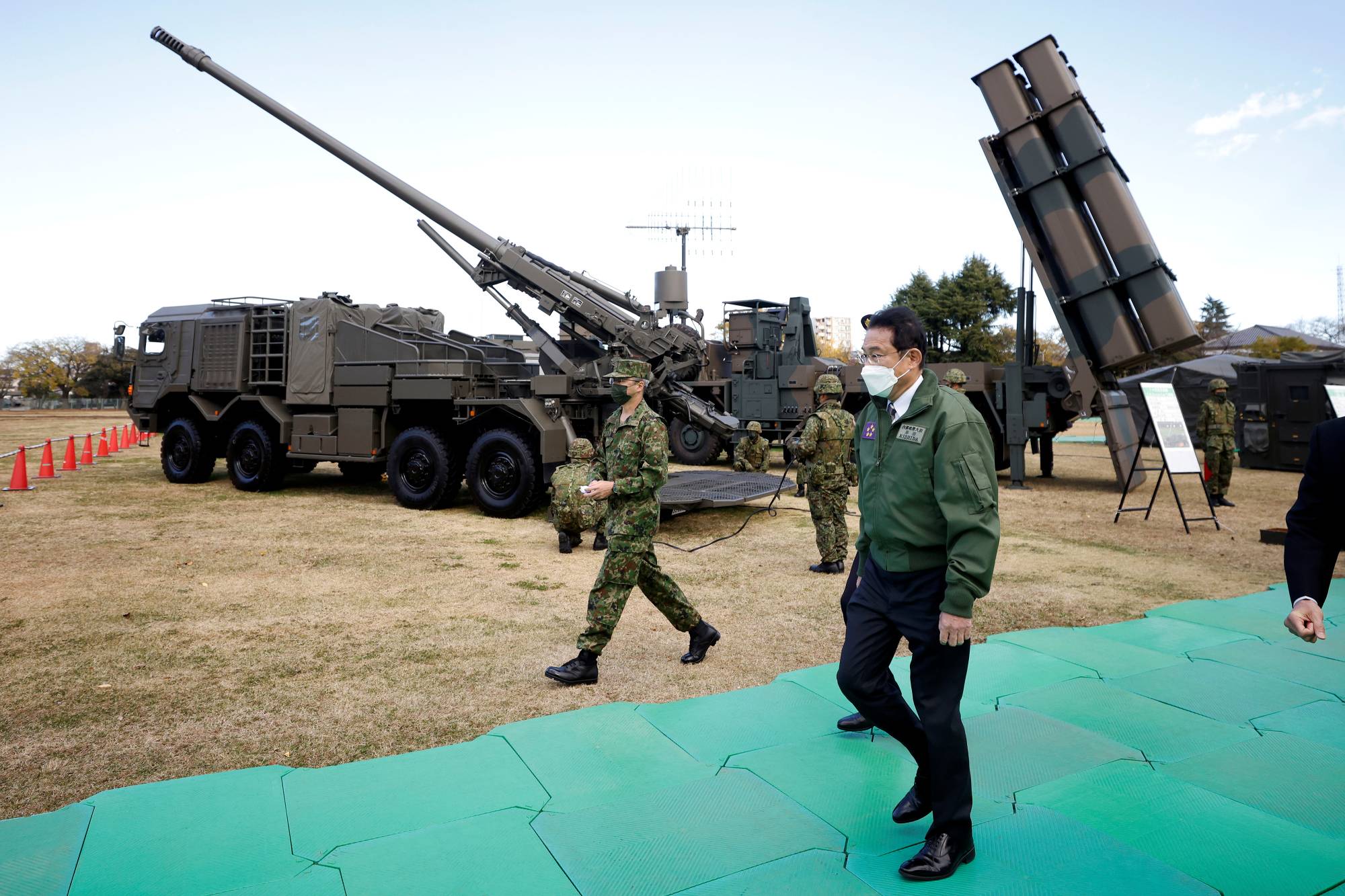
Concerned about China and North Korea's growing military capabilities, Japan has begun developing a series of missile systems designed to help defend itself at greater distances and keep enemy forces away — particularly from its southwestern islands.
Although announced just six months ago, the development of these so-called standoff weapons has become a priority for Tokyo, with the Defense Ministry awarding at least eight large contracts since April for the development or mass production of the new systems.
According to Jiji Press, these included a ¥58.4 billion ($419 million) contract with Mitsubishi Heavy Industries to start research on hypersonic missiles set to be deployed by 2032, and a ¥22.1 billion deal to develop a weapon that can be equipped with target observation capabilities.
Also included are a ¥200.3 billion contract to develop upgraded hypervelocity glide projectiles for island defense by 2031, and a ¥33.9 billion deal with Kawasaki Heavy Industries to conduct research on a new long-range, maneuverable “island defense anti-ship missile.” A potential prototype of that weapon was unveiled by the company at this year’s DSEI Japan defense exhibition in Chiba Prefecture.
Other awarded contracts relate not only to the series production of an upgraded, ground-launched Type-12 — with deliveries expected in 2026 or 2027 — but also further developments of the missile. These include a range extension to about 1,500 kilometers and the development of air- and ship-launched variants.
As a stopgap measure until the domestic missiles are ready, Tokyo is acquiring 400 Tomahawk cruise missiles with a range of about 1,600 km.
Japan also hopes to field a first variant of its hypervelocity glide projectiles, as well as submarine-launched missiles, within the next three to four years.
“All of these contracts have a similar purpose, which is to develop and strengthen Japan’s indigenous capacity to defend itself at greater distances to keep up with the defense improvements — both qualitatively and quantitatively — that China has made in the past decade or so,” said James Schoff, senior director of the U.S.-Japan NEXT Alliance Initiative at the Sasakawa Peace Foundation USA.
More precisely, these missiles are being developed to help defend Japan’s Nansei Islands. And insofar as a Chinese invasion of Taiwan would likely be accompanied by an attack on Okinawa, these missiles would indirectly contribute to Taiwan's defense, said military expert Yoshihiro Inaba.
But what exactly can these new systems do?
According to Inaba, all have very specific military advantages, although their intended targets can sometimes overlap. For instance, the hypersonic missiles, which are difficult to intercept given their high speeds, could be used to attack enemy ships and ground targets from a safe distance.
The new target observation munition is intended to operate in airspace difficult to penetrate by manned aircraft or large drones due to enemy air-defense systems. The weapon then searches for potential targets, transmitting that information.
The maneuverable hypervelocity glide projectiles are meant to deter China from attempting to seize Japanese territory — especially small islands — as they can be used to destroy enemy air-defenses as well as command-and-control sites in occupied territory. Analysts say these weapons will be extremely difficult to defend against, given their speed and trajectory, and should be highly accurate.
“This means that if China tried to set up an anti-ship missile battery on the Senkaku Islands, for example, it would be vulnerable to these weapons,” Schoff said.
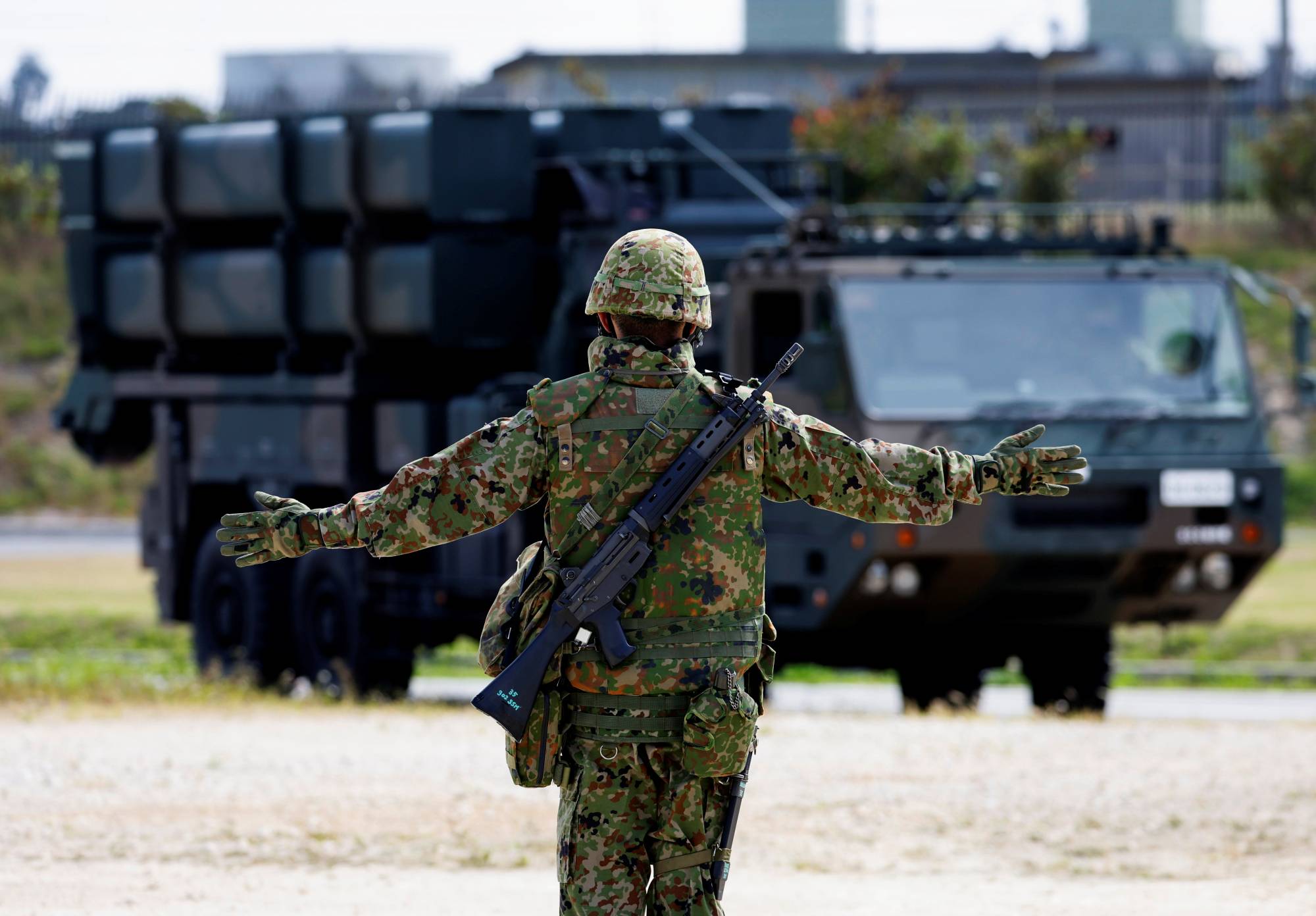
The new systems could also work in tandem. For instance, the hypersonic guided missiles and the target observation rounds have a similar purpose and can operate along with the high-speed glide vehicles.
“Hypersonic weapons, but especially the target observation rounds, could be effective against enemy ships, if they are mobile enough and able to access targeting data midflight,” Schoff said
Finally, the island defense anti-ship missile is a next-generation, stealthy and highly maneuverable weapon designed to attack enemy warships at ranges up to 2,000 km.
Overall, Tokyo is developing missiles that are designed to be stealthy to increase survivability, have longer ranges than previous Japanese weapons, and can be used for a strike if fitted with a warhead but can also be fitted with a surveillance capability or electronic signal jamming technologies, Schoff said.
As Japan develops these stealthy weapon systems, an “enemy would have a hard time holding onto any islands it tries to grab from Japan,” he added.
Japan’s defense doctrine, policy and legal structure still limit the country to self-defense, or limited collective self-defense, and the minimum necessary use of force when other options for defense are not available.
While the weapons would be primarily used to defend Japanese citizens and Self-Defense Forces personnel, the U.S. would also benefit from these weapons by having large areas around Japan well protected, thus allowing U.S. forces to focus elsewhere.
At the same time, the move is significant in terms of reinforcing Japan’s struggling defense-industrial capabilities, as it means that production capacity will now be directly under Tokyo’s control, which Schoff described as “a natural evolution, given the global demand for these systems and Japan’s desire to have more planning predictability regarding cost and system upgrades.”
The challenge, he said, is to sustain interoperability.
Indeed, these weapons need to be compatible with aircraft, ships and ground launchers in service, and ideally be interoperable with U.S. targeting systems for information sharing.
This means that although these weapons are unlikely to be co-developed with other countries, there will be close engagement with U.S. companies and the U.S. military in terms of how these systems work together with others either made with or purchased from Washington, so they can be used in joint operations between the allies.
Given the weapons’ complexity, analysts say the relatively fast planned deployment timeline — within a decade — is a testament to the skills of Japan’s industry but also the level of government funding.
As an example of this shift, Inaba points to the Type-12 anti-ship missile, which until now had a maximum range of only 200 km. Through upgrades, Japan plans to extend this to 1,500 km, and for other missiles, it is aiming for 3,000 km.
“Naturally, development of these will take time,” he said. “But still, it is quite speedy that the upgraded Type-12 will be deployed in 2026-27, even if the maximum range may not be realized by then.”
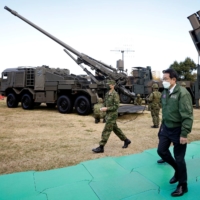
In a time of both misinformation and too much information, quality journalism is more crucial than ever. By subscribing, you can help us get the story right.
Skip to content
Your browser does not support JavaScript, or it is disabled.Please check the site policy for more information.
- National Report
- Korean Peninsula
- Around Asia
- Manga & Anime
The Asahi Shimbun
Japan to include standoff missile unit for enemy ‘counterstrikes’
THE ASAHI SHIMBUN
December 13, 2022 at 18:06 JST

The government will include a “standoff missile unit” capable of long-distance strikes against enemy bases under what it calls “counterattack capabilities” in three key national security policy documents that are now being revised.
The government presented the plan to a meeting of the ruling Liberal Democratic Party on Dec. 13.
The outline for the three documents said the standoff missile unit will become a core feature of the Ground Self-Defense Force for striking enemy bases that are planning to attack Japan, according to sources.
The unit will comprise seven surface-to-ship missile regiments, two high-speed gliding missile battalions for island protection, and two long-range guided missile troops.
Under the government’s plan, the unit will be armed with U.S.-made Tomahawk cruise missiles, Japan-made Type 12 surface-to-ship guided missiles, which are currently being upgraded, and hypersonic guided missiles.
The Type 12 missiles will include those that can be fired from the ground, ships and aircraft.
In addition, the GSDF and the Maritime Self-Defense Force will each have one new “information warfare unit.”
Since Russia started invading Ukraine in February, Japan’s Defense Ministry has been considering establishing warfare units to deal with information spread on the internet, including through social media platforms.
Related News

Missile battery in Okinawa to give Miyako Strait full protection

Defense Ministry eyes electronic warfare unit in Okinawa soon

Mitsubishi Electric attack likely stole data on new missile

Taiwan bolsters navy with unveiling of new amphibious warfare ship

Japan plans to develop longer-range missiles to counter China, Russia
Trending Now

Eiheiji temple scanned to make breathtaking virtual twin
April 26, 2024

A rare Hokkaido scene: Camera captures ito in spawning season

Eight injured after earthquake rocks Shikoku and Kyushu
April 18, 2024
Recommended

Stories about memories of cherry blossoms solicited from readers

Cooking experts, chefs and others involved in the field of food introduce their special recipes intertwined with their paths in life.

A series based on diplomatic documents declassified by Japan’s Foreign Ministry

A series on the death of a Japanese woman that sparked a debate about criminal justice policy in the United States

A series about Japanese-Americans and their memories of World War II

Here is a collection of first-hand accounts by “hibakusha” atomic bomb survivors.
Learning English
- Asahi Weekly
In-house News and Messages
- The New York Times
BACK TO TOP
- Site Policy
- Transmission of user information to external service providers(利用者情報の外部送信)
Copyright © The Asahi Shimbun Company. All rights reserved. No reproduction or republication without written permission.
Japan Announces Plan to Upgrade Its Type 12 Missiles to Fly Higher, Farther for Protection Against Future Sea Invasions
Tokyo now seems determined to rebalance the regional threat environment by improving the reach of its own Type 12 missiles.
A report from The National Interest specified that the Japan Self-Defense Force is supposedly only concerned with the Japanese soil's defense and doesn't have any offensive function.
The JSDF, as an island nation, is strongly orientation around maritime defense and naval power as a shield from sea invasions.
Nonetheless, improved sensors, propulsions systems, and communications enable land-based anti-ship missiles to impend targets hundreds of miles far from a shoreline.
Such weapons go beyond coastal defense and creep up ships across the littoral waters' broad swaths. More so, these technologies are changing the future naval conflicts' outlook.
Now, China, Japan's historical rival, and previous Japanese invasions have taken the lead in developing "far-reaching, land-based anti-ship and ballistic missiles," as indicated in this report.
ALSO READ: Elon Musk Plans to 'Chomp up' Space Junk Using SpaceX Starship as Garbage May Clog Earth's Orbit
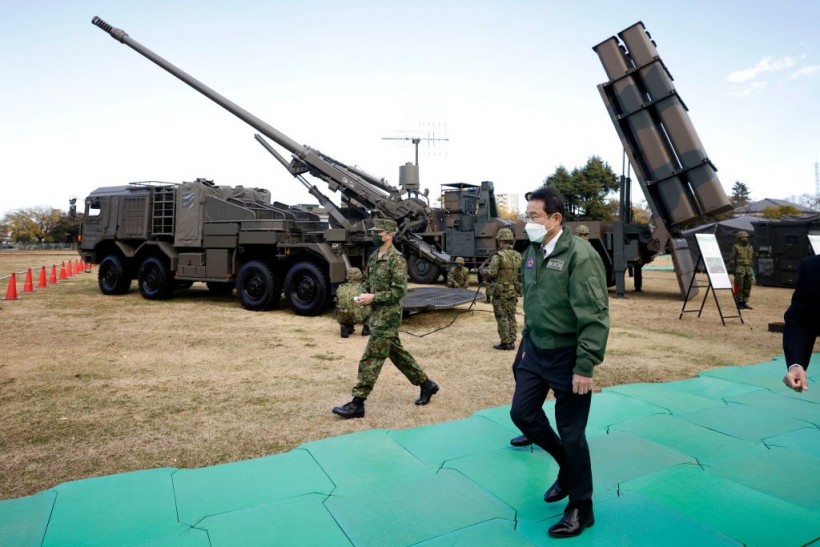
Type 12 Missiles
Essentially, the Japanese Ground Self-Defense Force or Group JGSDF operates the Type 12 anti-ship cruise missile on eight-wheel trucks.
In addition, a Type 12 battery usually comprises four ammunition carriers, four launcher vehicles, two radar vehicles, and two more trucks with communication systems and fire control.
Four batteries are presently concentrated at the Kengun Kumamoto, Japan's 5th Surface-to-Ship Missle Regiment. A pair of additional batteries, with a third one arriving soon, are stationed at Amami Oshima, Ishigaki, and ultimately, Miyako, Islands.
Each Type 12 launcher carries six missiles that weigh 1,500 pounds that are cruising towards a targeted vessel's position through a combination of GPS, inertia, and terrain-contour mapping for navigation.
The missile skims approximately 20 feet above the sea, stimulating a high-resolution active digitally scanned array seeker coming from the AA-4B air-to-air missile, which can identify if a ship is a suitable target and home in for the kill.
Nevertheless, Type 12 has a limitation compared to the latest anti- missile of China. Its range is just 124 miles.
Plan to Advance Capability with an Improved Model
Japanese warships and airplanes already utilized a variant of this missile, also known as Type 17, with double the range at 250 miles.
However, the JGSDF plans to leapfrog such a capability with the improved Type 12-Kai model, as detailed in a Naval News report, which enhances a range of 560 miles.
Furthermore, Type 17 is scheduled for completion of its development by 2025. Furth upgrading to more than 900-mile range is believed probable. That would approximately match the range of the DF-21D anti-ship ballistic missile.
Nonetheless, higher-flying missiles can be detected at farther distances on radar, providing the targeted ship with more warning to try shooting them down.
The Type 12 Kai has been improved for a decreased radar cross-section to alleviate this. It will possibly be programmed to dive to low altitude to the flight's final stage.
Type 12 is anticipated for deployment on Japan's F-15-derived Mitsubishi F-2 fighters. An air-launched Type 12 could feature a greater range due to starting with a speed at altitude boost and could approach target as well, from less foreseeable vectors, NewsDesk indicated in a similar report.
Lastly, the Japan Maritime Self-Defense Force P-1 maritime patrol planes reportedly can carry eight Type 12 missiles and the present model.
RELATED ARTICLE: Russia Anti-Satellite Weapon Trial: How Dangerous is This Missile Test for Humans in Space?
Check out more news and information on Tech & Innovation in Science Times.
Most Popular

Tapeworm in Brain Found To Be Culprit of Man's Severe Migraines; Eating Undercooked Bacon, Not Washing Hands Properly Could Be To Blame For Infection

RSS Tool "Saber" Set to Revolutionize the Oil and Gas Industry

Pink Moon Will Be Visible During Lyrid Meteor Shower; Here's the Best Time to Watch It
![type 12 cruise missiles Earth's Quasi-Moon Kamo‘oalewa Could Originate From Lunar Surface Not Asteroid Belt [Study]](https://1721181113.rsc.cdn77.org/data/thumbs/full/53275/89/56/50/40/earths-quasi-moon-kamo-oalewa-could-originate-from-lunar-surface-not-asteroid-belt-study.png)
Earth’s Quasi-Moon Kamo’oalewa Could Originate From Lunar Surface Not Asteroid Belt [Study]

Influenza Shows Highest 'Pandemic Potential' Among Ranked Pathogens, Study Reveals
Latest stories.

NASA Fermi Space Telescope Discovers Odd Supernova 'SN 2023ixf' With No Gamma Rays

Hubble Space Telescope Goes ‘Safe Mode’ After 1 Gyros Send Back Faulty Readings; NASA Is Fixing Mechanical Glitch

Emperor Penguins Face Threat of Extinction As 99% Could End Up Wiped Out by 2100 if Greenhouse Gas Emissions Persistently Rise, Study Reveals

Sun Releases 4 Solar Flares in Rare Super Explosion

UTI Vaccine Mouth Spray Could Prevent Infection Recurrence up to 9 Years, Study Reveals
Subscribe to the science times.
Sign up for our free newsletter for the Latest coverage!
Recommended Stories

NASA’s Voyager 1 Resumes Sending Readable Data From Deep Space After Months of Transmitting Nonsense Responses

Small Dark Formations on the Red Planet's Surface Appear Like Spider in Photos Captured by ESA's Mars Express

Citizen Scientists Identify New Sample of Over 1,000 Hidden Asteroids in Hubble’s Archival Data

NASA Engineers Successfully Repair Voyager 1 After 5 Months of Troubleshooting 15 Billion Miles Away

Japan to Approve Sub-Launched Long-Range Missile Development: Report

The Japanese government has decided to acquire submarine-launched long-range missile capability, The Mainichi reported .
The decision, to be detailed in three security documents, will be approved soon.
The underwater capability is part of Tokyo’s “counter-strike” strategy to take out enemy missile launch sites before attack .

Vertical Launch System
The country is considering an improved version of the domestically-produced Type 12 surface-to-ship guided missile and the Raytheon Tomahawk cruise missile for the purpose.
The upgraded Type 12 is expected to have a range of 750 miles (1,207 kilometers), while the Tomahawk has a range of 1,000 miles (1,609 kilometers).
The missiles will be launched with a vertical launch system outfitted on top of the submarine’s hull, the Japanese outlet explained.
The country’s 21 submarines currently lack vertical launch capability, necessitating retrofitting.
$37 Billion in Defense Spending
The government is reportedly considering spending around 5 trillion yen ($37 billion) over the next five years to develop the capability, including 800 billion yen ($5.86 billion) on “high-speed glide weapons.”
Tokyo is also planning to acquire 13 aerial refueling and transport aircraft, 5 E2D early warning aircraft, 3 RC2 radio information collectors, and one standoff electronic warfare aircraft by fiscal 2027, according to The Mainichi.
Other planned investments include the deployment of the Patriot surface-to-air guided missile PAC 3 MSE, the new interceptor missile SM6, and two Aegis-equipped ships.
Subscribe to our mailing list
Related articles.
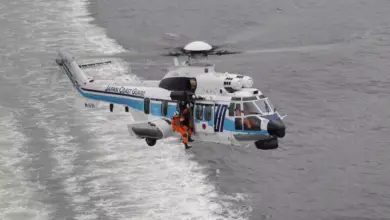
Japan Orders Three H225 Helicopters From Airbus

US, Japan Confirm Cooperation on Counter-Hypersonic Development
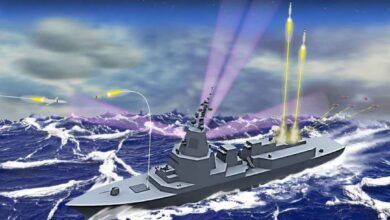
Lockheed Successfully Tracks Space Objects With SPY-7 Radar
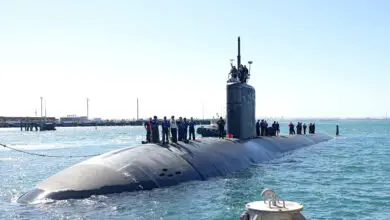
Australia to Upgrade Future Nuclear Submarine Infrastructure on Garden Island

Japan Procures First Fleet of UGVs From Rheinmetall
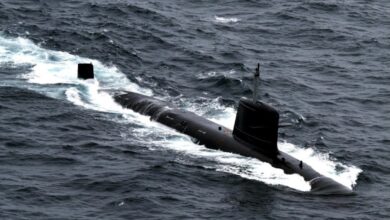
Indonesia Buys Two Submarines From France’s Naval Group

Japanese Soldiers Complete US-Led Tomahawk Land Attack Missile Training
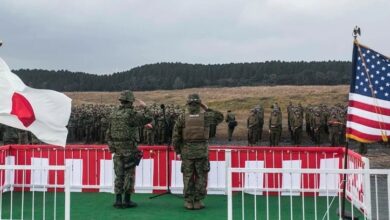
US Mulls Major Overhaul of Military Command in Japan: Report
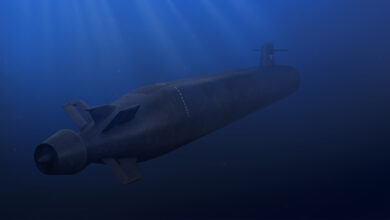
Naval Group Begins Construction of France’s Third-Gen Nuclear Submarine
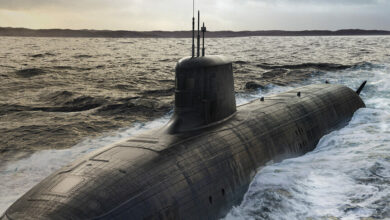
Australia Picks BAE to Build Multibillion-Dollar Nuclear Submarines
- Air Warfare
- Cyber (Opens in new window)
- C4ISR (Opens in new window)
- Training & Sim
- Asia Pacific
- Mideast Africa
- The Americas
- Top 100 Companies
- Defense News Weekly
- Money Minute
- Whitepapers & eBooks (Opens in new window)
- DSDs & SMRs (Opens in new window)
- Webcasts (Opens in new window)
- Events (Opens in new window)
- Newsletters (Opens in new window)
- Events Calendar
- Early Bird Brief
- Digital Edition (Opens in new window)
French missile double punch adds new naval capability for Europe
PARIS — France’s synchronized test firing of naval cruise missiles from a surface ship and a submarine 400 kilometers apart adds a land-attack capability for European navies that may be more difficult for air defenses to counter, analysts told Defense News.
The French frigate Aquitaine and a Suffren-class nuclear-powered attack submarine, sailing near Quimper and Biscarosse, respectively, last week each fired a Missile de Croisière Naval or MdCN that simultaneously hit a target at a military testing site in south-west France, a first for the French Navy.
Coordinated cruise missile strikes could be used to saturate adversary defense systems, raising the chance of a successful hit on defended targets in a high-intensity context, the French Navy said in statement to Defense News. The synchronized double shot of the domestically developed MdCN relied on existing systems and software, the service said.
The French Navy’s coordinated launch from different platforms “is a notable development,” said Nick Childs, senior fellow for Naval Forces and Maritime Security at the International Institute for Strategic Studies in London. “Being able to carry out strikes from different platforms in different locations at the same time complicates the air-defense challenge for the opponent.”
Whether it’s possible to actually saturate air defenses depends on how many missiles can be launched and the sophistication of the defense, Childs said. He said both France and the U.K. already had the ability to carry out complex strikes through the combination of air-launched missiles and weapons from naval platforms.
The synchronized cruise-missile firing is “something special,” as few navies in Europe perform land strikes, said Sebastian Bruns, senior researcher at the Institute for Security Policy Kiel University (ISPK). He said the exercise is “more of a capability demonstrator,” meant to validate the technology and telegraph the implications to would-be adversaries at the same time.
The political winds surrounding such military capabilities are changing, he added. “Land attack is entering the realm of the imaginable.”
The MdCN is France’s answer to the U.S.-made Tomahawk, and was developed by pan-European missile maker MBDA following a contract in 2006. The naval cruise missile entered service in 2017 and was used operationally by France for the first time in strikes against Syria in 2018.
“This development gives some operational advantage to the French Navy as a single service and more options for French planners,” Childs at the IISS said. “But it is probably not a game-changer in terms of capability.”
The French Navy said it regularly trains on multiple missile launches from different carriers, with trajectory coordination and synchronized missile arrival the most important training goals. Training on joint strikes is also planned with U.S. and U.K. partners, with regular exercises on coordinating trajectories and missile arrivals, according to the Navy.
Missile coordination is an active field of research, and a Google Scholar search for the term finds dozens of studies since 2023, including on neural networks for warhead coordination and ant-colony-based algorithms for missile-flight planning. Of the first 20 studies that show up, 16 are by authors affiliated with Chinese research institutes and companies.
While the U.S. can carry out this type of synchronized firing from different carriers, the U.K. only has this capability on its nuclear-powered attack submarines, according to the French Navy. The U.K.’s Trafalgar-class submarine Triumph fired Tomahawk missiles at Libyan air defenses during Operation Ellamy in 2011.
The U.K. Royal Navy aims to have similar options when its Type-26 frigates enter service with the ability to launch cruise missiles, Childs said. The Navy’s current Type-45 destroyers were originally intended to be fitted with land-attack cruise missiles, but that was never funded, he said.
The long-range capability provided by the MdCN “makes it possible to impose a military threat from the very outset of a crisis, thus influencing the will of competitors,” the French Armed Forces Ministry said in statement last week.
The French naval cruise missile is powered by Safran’s Microturbo TR 50 engine, and has a speed of around 1,000 kilometers per hour and a range of about 1,000 kilometers, according to official data . The 6.5-meter, 1.4-metric ton missile is launched using a first-stage booster that separates before wing deployment, and French submarines can launch the missile from their torpedo tubes in a protective shell that is discarded on breaking the surface.
Firing cruise missiles from a naval platform provides a permanent presence and “undeniable freedom of action” at sea, as there are no diplomatic overflight constraints, the Navy said. The use from a submarine also allows for actions that require greater discretion, it said.
The Netherlands has said it will equip its four current Zeven Provinciën-class frigates with Tomahawk missiles during maintenance in the 2025-2029 period, adding a land deep-strike capability the Dutch navy currently lacks. The Dutch also plan to fit the cruise missiles to their future air-defense frigates and submarines .
Sebastian Sprenger in Cologne, Germany, contributed to this report.
Rudy Ruitenberg is a Europe correspondent for Defense News. He started his career at Bloomberg News and has experience reporting on technology, commodity markets and politics.
More In Europe
Austin calls European allies, seeking more Patriots for Kyiv
The u.s. secretary of defense has held multiple one-on-one calls with european allies this week, during which he raised the topic..
Defense Innovation Unit moves to ease commercial drone certifications
Diu wants to improve its process for vetting commercial drones, with the goal of making it easier for companies to sell their systems to the u.s. military..
Saab unveils technology incubator using Enforcer 3 as test bed
“we are trying to get capability to the fleet in months,” said erik smith, the chief executive of saab's u.s. branch..
Lockheed to supply Australia with air battle management system
Overhauling australia’s overhead defenses is expected to generate hundreds of local jobs as well as open the door to a multibillion-dollar export market..
Defense Innovation Unit prepares to execute $800 million funding boost
Diu director doug beck said he doesn’t foresee any issues with quickly putting to work the $983 million in fy-24 funding congress provided in march., featured video, military times’ 2024 service members of the year.
From combat medic to Paralympian: What drives Ellie Marks?
The Navy petty officer ensuring the Carney stays focused on the fight
Ukraine-born airman’s translations aided allied efforts as war erupted
Trending now, sierra nevada wins $13b contract to build air force ‘doomsday plane’, france and germany sign off on future battle tank system, us army to field long-range combat aircraft to first unit in fy31, lidar: another emerging technology brought to you by china.
What missiles could Israel use in an attack - and can Iran defend itself?
Sky News looks at how Israel might attack, and how Iran could respond.
By Ben van der Merwe and Saywah Mahmood, Data and Forensics Unit
Friday 19 April 2024 09:48, UK
Please use Chrome browser for a more accessible video player
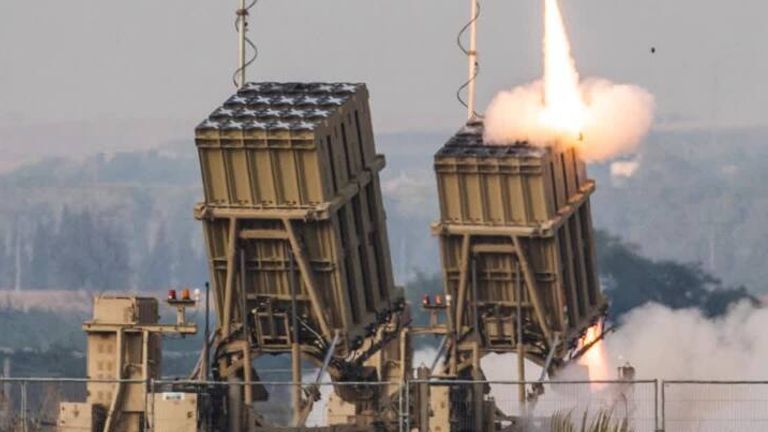
Israel has launched a strike against Iran in retaliation for Tehran's unprecedented missile-and-drone assault on the country at the weekend.
Experts previously told Sky News Israel was likely to be considering an airstrike on critical Iranian infrastructure, including air bases and nuclear facilities.
Israel is well-equipped for such an operation. The country possesses 39 state-of-the-art F-35 stealth fighter jets, the fifth largest inventory in the world.

Sky News security and defence analyst Michael Clarke says the planes are "pretty well invisible".
"It is rumoured that Israeli F-35s have already been around and about Iranian airspace on surveillance missions," he said earlier this week.
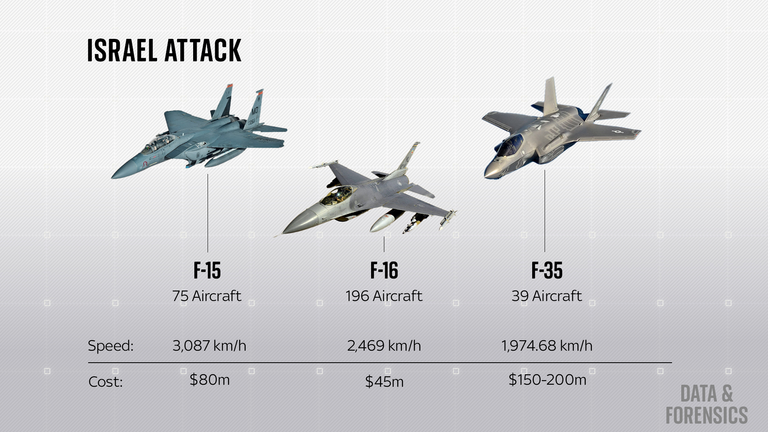
'We are 100% ready'
At a military parade on Wednesday, Iran's president Ebrahim Raisi hailed the attack on Israel and warned against any retaliatory action. "We are 100% ready in all aerial fronts," he said.
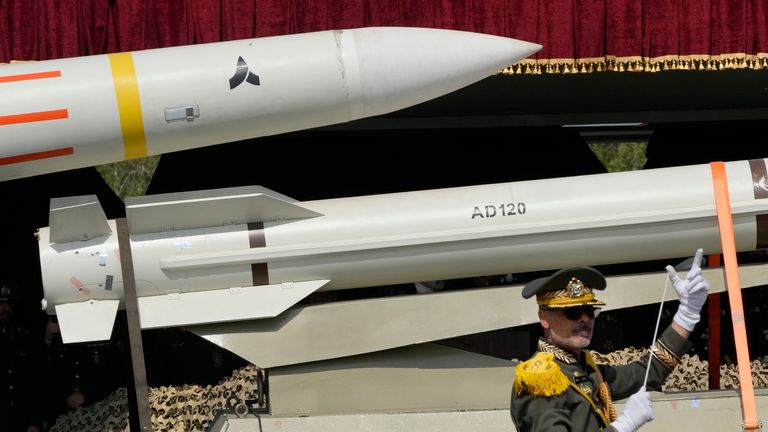
"The Iranians have worked hard on improving their air defences in recent years, but how good they are is an open question," says Fabian Hinz, a research fellow at the International Institute for Strategic Studies (IISS).
Iran is known to possess at least 42 long-range surface-to-air missile launchers, including 32 Russian-made S-300 launchers that it acquired in 2016.

In 2018, however, it was reported that Israeli pilots had travelled to Ukraine to practice evading the S-300, which Ukraine is known to possess.
As a result, Mr Hinz says, Iran has increasingly invested in designing its own air defence systems.
What air defence systems does Iran have?
One of the first such systems, the Sevom Khordad, was reportedly used to down a US Global Hawk drone over the Persian Gulf in 2019.
An updated version of the Sevom Khordad, the Khordad-15, was unveiled in 2019 and is under the command of Iran's elite Revolutionary Guards. Iran claims it can engage enemy fighters at a range of 75km.
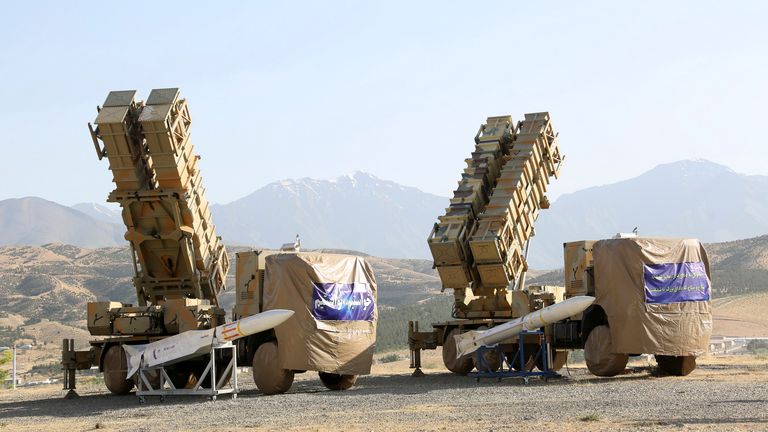
In 2022, Iran unveiled an updated version of the Khordad-15 called Tactical Hunter. Iran says the system has a range of 120km and is defended by its own short-range missile system.
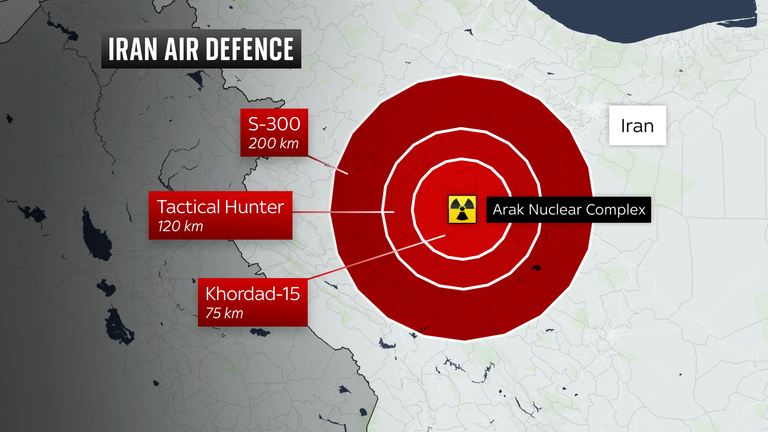
Two new defence systems were unveiled in February, but it is not yet clear whether they are operational.
The Arman is reportedly able to engage six ballistic missiles simultaneously at ranges of 120-180km, while the Azarakhsh is said to be able to destroy low-altitude targets within a 50km radius.
"I would guess that the Israelis would be quite good at disabling [Iran's air defences] through jamming and electronic warfare, although we don't know for sure," says Mr Hinz.
If Israel wanted to avoid Iran's air defence systems entirely, it could opt to fire a missile from an aircraft outside Iranian airspace.
Neighbouring countries are unlikely to grant Israel permission to use their airspace, but Mr Hinz says they are also unlikely to try and shoot down Israeli aircraft.
Little is known about Israel's Jericho missiles
Israel could avoid violating its neighbours' airspace by utilising ballistic missiles launched from its own territory.
"If Israel carried out a similar ballistic missile attack to Iran, Iran would certainly struggle to intercept it in the same way," says Jeremy Binnie, Middle East and Africa editor at Janes, the defence intelligence company.
However, it's unclear whether Israel has the capabilities to launch a similar attack. Israel's ballistic missile programme, called Jericho, is highly classified.
Few details are in the public domain, but the IISS estimates Israel has about 24 nuclear-capable Jericho II missiles.
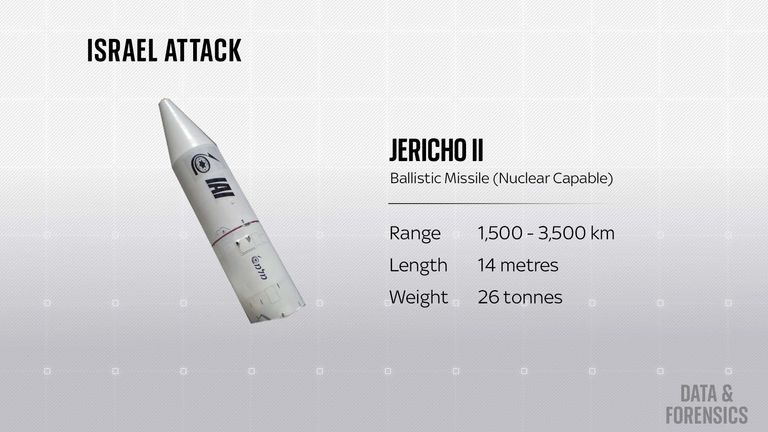
"They have submarine-launched cruise missiles and ballistic missiles which they almost certainly use for their nuclear deterrent," says Mr Hinz.
"But do they have conventional, precision-guided versions that they could use? We just don't know."
A learning opportunity for both militaries
Of the more than 330 missiles and drones launched as part of Iran's attack, US officials say that around half failed to launch or crash landed.
Just nine missiles hit their targets within Israel, with the rest being intercepted by Israel, Jordan and Western forces.
"This obviously doesn't look very successful from Iran's point of view, but actually they now have a much better idea of Israel's capabilities," says Mr Binnie.
However, Mr Hinz says that Israel will also have used the assault as an opportunity to test its air defences.
"With every use of their missile defence systems, they can improve the algorithms, they can improve the operating procedures," he says.
The Iron Dome , a system of radar-guided missile launchers, has consistently blocked more than 90% of short-range rockets fired towards Israel.
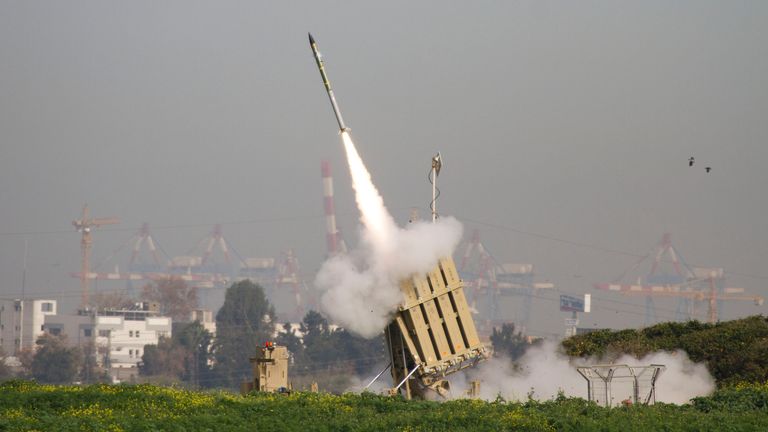
Mr Hinz says that the system has been subject to continuous software updates which have rendered it more effective.
Two other systems, Arrow and David's Sling, are capable of intercepting ballistic missiles at much further distances. Arrow is capable of flying at hypersonic speeds and intercepting missiles beyond the Earth's atmosphere.
The US has said that Israel's air defences proved their effectiveness in the attack, which caused no fatalities and only minor damage.
"But how much can we attribute that to the help from the Americans and others?" asks Mr Binnie.
"Could the Israeli Air Force have shot them all down by itself? Well, it might well have struggled, quite frankly."

Iran's attack capabilities have been improving
The attack may also have given Israel a better idea of Iran's offensive capabilities.
On Tuesday, Sky News was shown the remains of an Iranian Emad-1 missile at a military base in Israel.

It is similar to Iran's Ghadr missile, first tested in 2004, but with additional precision targeting capabilities.
Both missiles have a range of more than 1,500 kilometres - putting all of Israel well within their sights.
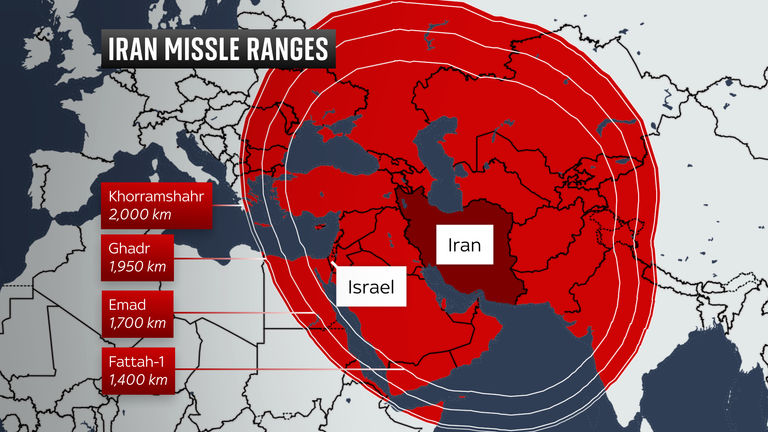
"I would say that what they fired is basically what they have in their arsenal," says Mr Hinz. "It's not that they restrained [themselves] and just used their less sophisticated weapons."
One possible exception is the Fattah, an Iranian-designed weapon unveiled last year.
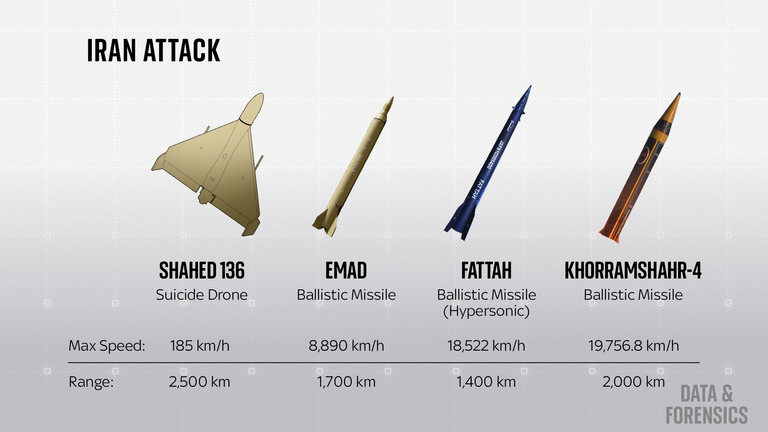
"They've shown us testing footage, but we don't know if it's operational," Mr Hinz says.
A rocket motor on the warhead of the Fattah could allow it to conduct evasive manoeuvres outside the atmosphere and to increase the speed of its final descent.
"It's specifically designed to beat Israeli air defences," says Mr Binnie.
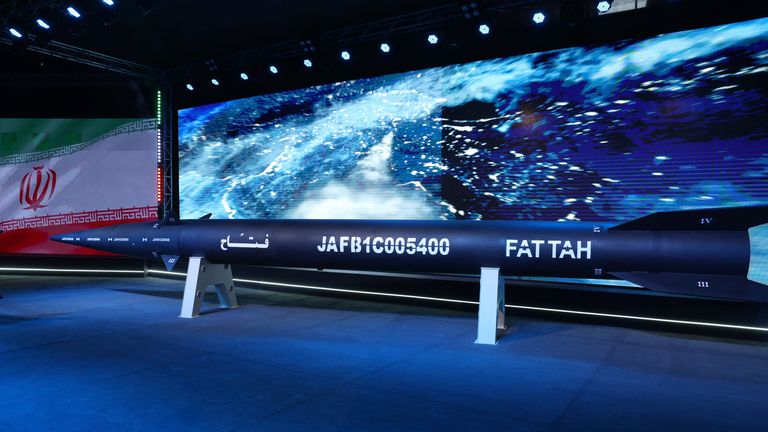
Another missile unveiled last year, the Khorramshahr, is still thought to be under development.
"The Khorramshahr has a big old warhead on it, 2,000kg, so in theory that's going to be quick and harder to intercept," Mr Binnie says.
Read more on Sky News: Is it safe to travel to holiday destinations as Middle East tension escalates? Are we heading for World War Three? Experts give their verdicts
It's impossible to know how these weapons will perform against Israel's air defences until they are actually used.
"The precision they've achieved is quite impressive, but it doesn't really help if your opponent's defensive systems are even more impressive," Mr Hinz says.
For Iran to cause significant damage to Israel, it may have to rely on increasing the quantity, rather than the quality, of its missiles.
"There will be an upper limit at some point where you've got so many ballistic missiles coming in, Israel just can't shoot them all down," says Mr Binnie. "What that point is, we don't know."
The US estimates that Iran's arsenal includes more than 3,000 ballistic missiles, but it's not clear how many it would be able to launch at once.
Mr Hinz says that the logistical effort in launching 120 missiles simultaneously will already have been enormous - likely involving hundreds or thousands of people.
"Can they scale it up? My guess would be that they could, but perhaps not to a large degree."
If Iran wants to overwhelm Israel's air defences, it is likely to rely on the involvement of Lebanese militia Hezbollah. Lebanon is just 115km from Israel's Tel Aviv, whereas missiles fired from Iran must travel more than 1,000km to reach Israel's commercial centre.
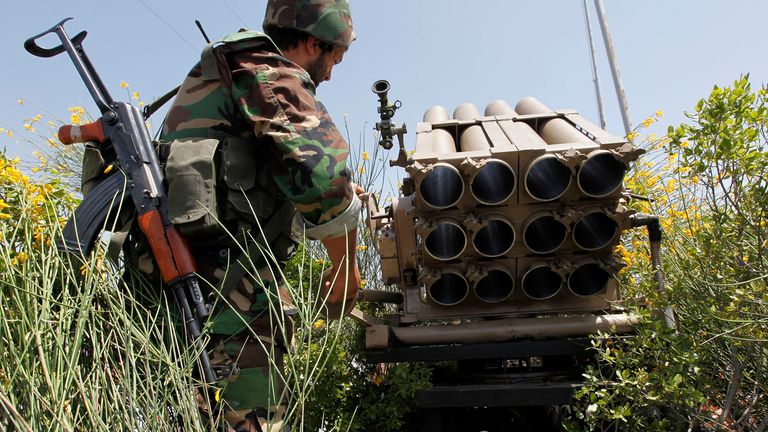
"They're just much closer to Israel and so they can use much cheaper systems," Mr Hinz says. "As a result, they have many, many more than Iran."
The CIA estimates that Hezbollah has more than 150,000 missiles in its arsenal.
The risk for Iran would be that Israel responds forcefully against Hezbollah, one of its most valuable allies. In December, Israeli Prime Minister Benjamin Netanyahu threatened to turn the Lebanese capital Beirut "into Gaza".
Ultimately, Mr Hinz says, it could come down to a matter of attrition.
"If this becomes a sustained confrontation, someone is going to run out of missiles first," he says.
"Does Iran have more ballistic missiles, or does Israel have more interceptor missiles? We just don't know."
Additional reporting by Sam Doak.
The Data and Forensics team is a multi-skilled unit dedicated to providing transparent journalism from Sky News. We gather, analyse and visualise data to tell data-driven stories. We combine traditional reporting skills with advanced analysis of satellite images, social media and other open source information. Through multimedia storytelling we aim to better explain the world while also showing how our journalism is done.
Related Topics
- Data and Forensics
- Israel-Hamas war
- Election 2024
- Entertainment
- Newsletters
- Photography
- Personal Finance
- AP Investigations
- AP Buyline Personal Finance
- AP Buyline Shopping
- Press Releases
- Israel-Hamas War
- Russia-Ukraine War
- Global elections
- Asia Pacific
- Latin America
- Middle East
- Election Results
- Delegate Tracker
- AP & Elections
- Auto Racing
- 2024 Paris Olympic Games
- Movie reviews
- Book reviews
- Personal finance
- Financial Markets
- Business Highlights
- Financial wellness
- Artificial Intelligence
- Social Media
North Korea says it tested ‘super-large’ cruise missile warhead and new anti-aircraft missile
Korean Central News Agency released photos showing at least two missiles being fired off launcher trucks on a runway. The missiles in the image were not identified. State media said North Korea’s missile administration on Friday conducted a ‘power test’ for the warhead designed for the Hwasal-1 Ra-3 strategic cruise missile and a test-launch of the Pyoljji-1-2 anti-aircraft missile.

The South Korean and U.S. air forces held joint air drills in Gunsan, South Korea on Friday, where they practiced ways to detect and counter enemy threats.
A TV screen shows an image of North Korea’s missile launch during a news program at the Seoul Railway Station in Seoul, South Korea, Saturday, April 20, 2024. North Korea said Saturday it tested a “super-large” cruise missile warhead and a new anti-aircraft missile in a western coastal area as it expands military capabilities in the face of deepening tensions with the United States and South Korea. (AP Photo/Ahn Young-joon)
- Copy Link copied
South Korean army soldiers pass by the barbed-wire fence in Paju, South Korea, near the border with North Korea, Friday, April 19, 2024. (AP Photo/Ahn Young-joon)
A U.S. Army soldier from the Eighth Army and South Korean army soldiers throw simulated grenades during the Expert Soldier, Infantry, and Medic Badge (E3B) competition at the Rodriguez Live Fire Complex in Pocheon, South Korea, Friday, April 19, 2024. (AP Photo/Ahn Young-joon)
U.S. Army soldiers from the Eighth Army compete during the Expert Soldier, Infantry, and Medic Badge (E3B) competition at the Rodriguez Live Fire Complex in Pocheon, South Korea, Friday, April 19, 2024. (AP Photo/Ahn Young-joon)
SEOUL, South Korea (AP) — North Korea said Saturday it tested a “super-large” cruise missile warhead and a new anti-aircraft missile in a western coastal area as it expands military capabilities in the face of deepening tensions with the United States and South Korea.
North Korean state media said the country’s missile administration on Friday conducted a “power test” for the warhead designed for the Hwasal-1 Ra-3 strategic cruise missile and a test-launch of the Pyoljji-1-2 anti-aircraft missile. It said the tests attained an unspecified “certain goal.”
Photos released by the North’s official Korean Central News Agency showed at least two missiles being fired off launcher trucks at a runway.
North Korea conducted a similar set of tests Feb. 2, but at the time did not specify the names of the cruise missile or the anti-aircraft missile, indicating it was possibly seeing technological progress after testing the same system over weeks.
KCNA insisted Friday’s tests were part of the North’s regular military development activities and had nothing to do with the “surrounding situation.”
Tensions on the Korean Peninsula are at their highest in years, with North Korean leader Kim Jong Un dialing up his weapons demonstrations, which have included more powerful missiles aimed at the U.S. mainland and U.S. targets in the Pacific. The United States, South Korea and Japan have responded by expanding their combined military training and sharpening their deterrence strategies built around strategic U.S. assets.
Cruise missiles are among a growing collection of North Korean weapons designed to overwhelm regional missile defenses. They supplement the North’s vast lineup of ballistic missiles, including intercontinental ballistic missiles aimed at the continental United States.
Analysts say anti-aircraft missile technology is an area where North Korea could benefit from its deepening military cooperation with Russia , as the two countries align in the face of their separate, intensifying confrontations with the U.S. The United States and South Korea have accused North Korea of providing artillery shells and other equipment to Russia to help extend its warfighting in Ukraine.
North Korea conducts cruise missile warhead test on Friday, KCNA says
- Medium Text
Sign up here.
Reporting by Heekyong Yang and Josh Smith; Editing by Chris Reese and Bill Berkrot
Our Standards: The Thomson Reuters Trust Principles. New Tab , opens new tab

World Chevron

US senator questions whether State Dept properly assessing Israel conduct
A Democratic senator on Sunday questioned whether the Biden administration was properly assessing whether Israel was complying with international law, following a Reuters report that some senior U.S. officials did not find that country's assurances credible.
Burkina Faso has suspended a number of Western and African media over their coverage of a Human Rights Watch (HRW) report accusing the army of extrajudicial killings, its communications authority said on Sunday.

What Iran’s attack on Israel revealed about its weapons arsenal
Iran’s first direct attack on Israel overnight Saturday demonstrated the country’s military might and the advances of its domestic weapons program, analysts said, while also revealing the limitations of its arsenal.
With more than 300 drones and missiles launched in a layered onslaught, it was Iran’s largest-ever conventional show of force . That it inflicted only minimal damage was due in part to the choreographed nature of the attack — giving Israel and the United States ample time to prepare air defense systems — but may also be attributed to shortcomings in its medium- and long-range capabilities.
“The operation showed that our armed forces are ready,” Iranian president Ebrahim Raisi told crowds gathered Wednesday in Tehran to mark Army Day. Parades in the Iranian capital featured many of the same munitions used in the attack on Israel.

What Iran used against Israel
110 ballistic
Iranian drones
These drones can deliver small payloads of explosives in self-detonating attacks.
Length: 11.5 ft.
Width: 8 ft.
Max. take off weight: 440 lb.
Max. speed: 115 mph
Range: About 1,100 - 1,500 miles
Its nose contains a warhead and can be equipped with a camera.
Length: 8 ft.
Width: 7 ft.
Max. take off weight: 300 lb.
The Shahed-131 is an earlier version of Shahed-136 with a similar principle of operation. The layout and aerodynamics are also identical.
Ballistic missiles
KHEIBAR SHEKAN
The Kheibar Shekan MRBM is a solid-propellant ballistic missile designed by the IRGC.
Length: 34 ft.
Diameter: 2.6 ft.
Max. range: 900 miles
Warhead weight: 1,100 lb.
Introduction: 2022
The Emad MRBM is an Iranian-designed, liquid-fuel ballistic missile based on Shahab-3.
Length: 54 ft.
Diameter: 4.1 ft.
Max. range: 1,056 miles
Warhead weight: 1,650 lb.
Introduction: 2015
The Ghadr-1 MRBM seems to be an improved variant of the Shahab-3A. It is also referred to as the Ghadr-101 and the Ghadr-110.
Max. range: 1,211 miles
Warhead weight: 1,760 lb.
Introduction: 2007
Cruise missile
Max. range: 1,025 miles
Introduction: 2023
What Iran did not use
The Sejjil-1 Iranian MRBM is a two-stage, solid-propellant, surface-to-surface missile.
Length: 60 ft
Max. range: 1,243 miles
Warhead weight: 1,540 lb.
Introduction: 2011
The Shahab-3 is a MRBM developed by Iran and based on the North Korean Nodong-1.
Diameter: 4.1 or 4.5 ft.
Max. range: 808 miles
Warhead: Single or multiple
with 5 warheads of 617 lb.
Introduction: 2003
Sources: OE Data Integration Network (ODIN),
CSIS Missile Defense Project

120 ballistic

120 ballistic missiles
30 cruise missiles
Overhead view
1,211 miles
1,056 miles
Max. range:
Warhead weight:
Introduction:
Sources: OE Data Integration Network (ODIN), CSIS Missile Defense Project

Raisi hailed the attack as a resounding “success,” but was also quick to qualify the strikes as “limited” and “not comprehensive.”
“If it was supposed to be a large-scale action, nothing would have been left of the Zionist regime,” he said. And if Israel retaliates, Raisi pledged, “they will be dealt with fiercely and severely.”
Yet after analyzing the munitions used in Saturday’s assault and the success of regional defense systems, researchers say it’s unclear how Iran could inflict greater damage on Israel through conventional military means.
“Iran basically threw everything it had that could reach Israel’s territory,” said John Krzyzaniak, a researcher who studies Iran’s missile programs at the Wisconsin Project on Nuclear Arms Control. Like other analysts interviewed for this story, he has spent the past several days studying launch videos, imagery of debris and interception information to identify the Iranian munitions.
His conclusion is that Tehran “used some of every system they have.” And experts said it made sense that the Sejjil-1 and Shahab-3 missiles were excluded from the attack.
Shahab-3 “wasn’t used because it’s so old,” said Fabian Hinz, an Iran analyst at the International Institute for Strategic Studies in Berlin. “The Sejjil is a bit of a mysterious missile,” he said, adding that Iran has “used it very, very little during maneuvers.”
Other analysts noted the Sejjil was expensive to produce and may no longer be in production.
The quantity of munitions used also provides new insights into Iran’s capabilities. The deployment of over 100 ballistic missiles in a single wave suggests that previous estimates that Iran has about 3,000 ballistic missiles stockpiled are probably accurate, and could even be on the low end.
“If this is just round one of an unknown number of rounds to come, you wouldn’t fire a significant fraction of what you have just in the first round,” Krzyzaniak said.
The firing of over 100 ballistic missiles in the space of a few minutes suggests Iran has at least 100 launchers, he added — a new data point for researchers.
“This shows that Iran has really faced no limitation in domestically producing missiles and launchers,” he said.
Iran’s ballistic missile arsenal, the largest of any country in the Middle East, is almost entirely homegrown. In recent years Iran has demonstrated the ability to upgrade some systems, improving their range and precision.
The spokesman for Iran’s armed forces, Abolfazl Shekarchi, said the munitions used in the strikes against Israel only represented “a fraction of” the country’s military’s might, according to a statement published on state-run media.

The evolution of Iran’s
missile program
In the mid-1980s, Tehran acquired Scud missiles from Libya, Syria and North Korea and also began adapting the technology for their own missile variants. During the eight-year war with Iraq, Tehran countered primarily with Scud B missiles, which have a range of 185 miles.
Shahab-1 , 186 miles
1994 to 2001
Iran developed its own version of the Scud B, the Shahab-1, and from 1994 to 2001 fired it at bases in Iraq used by the opposition group Mujahedin-e Khalq.
A new generation of missiles
After 16 years without firing new missiles, Iran showed its technological advances in 2017 striking on an ISIS command center with 6 Zolfaghars with a range of 430 miles. In early 2024, it launched strikes against Islamic State targets in northwest Syria using Kheibar Shekan missiles that travelled 745 miles from Iran to Syria.
Fahteh 110 , 181 miles
Fahteh 313 , 310 miles
Zolfaghar , 435 miles
Qiam 1 , 497 miles
Kheibar Shekan , 900 miles
IRAN ATTACKS
Against ISIS
6 ballistic missiles
Deir ez-Zor, Syria
Against Kurdish dissidents
7 ballistic missiles
Abu Kamal, Syria
Against Oil fields and facilities
18 drones + 7 cruise missiles
Abqaiq, S. Arabia
Khurais, S. Arabia
3 cruise missiles
Against U.S. forces
Erbil, Iraq
1 ballistic missile
Ain Al Asad, Iraq
15 to 22 ballistic missiles
Against “Israeli strategic centers”
At least 10 ballistic missiles
73 launches + at least 20 drones
and suicide drones
Sulaimaniyah,
Against IS targets
Harem, Syria
Israeli “spy headquarters”
Against Jaish ul Adl
Balochistan,
Missiles and drones
Against Israel
120 ballistic missiles,
170 drones,
Sources: United States Institute of Peace, CSIS, IDF

The evolution of Iran’s missile program
IRAN TARGETS
KNOWN MISSILE
Zolfaghars,
Abqaiq, Saudi Arabia
Khurais, Saudi Arabia
Zolfaghars and
potentially
Ballistic missiles and suicide drones
Sulaimaniyah, Iraq
Kheibar Shekan
Balochistan, Pakistan
Missiles and drones against Jaish ul Adl
170 drones, 30 cruise missiles
Before the attack on Israel, Iran’s most significant use of ballistic missiles was in 2020, after a U.S. drone attack killed the powerful Iranian commander Qasem Soleimani.
Iran launched more than a dozen ballistic missiles at two U.S. military bases in Iraq, one in the country’s west and one in the north. While there were no fatalities, dozens of U.S. service members suffered traumatic brain injuries.
Iran also used ballistic missiles in strikes this year on Pakistan, Syria and Iraq.
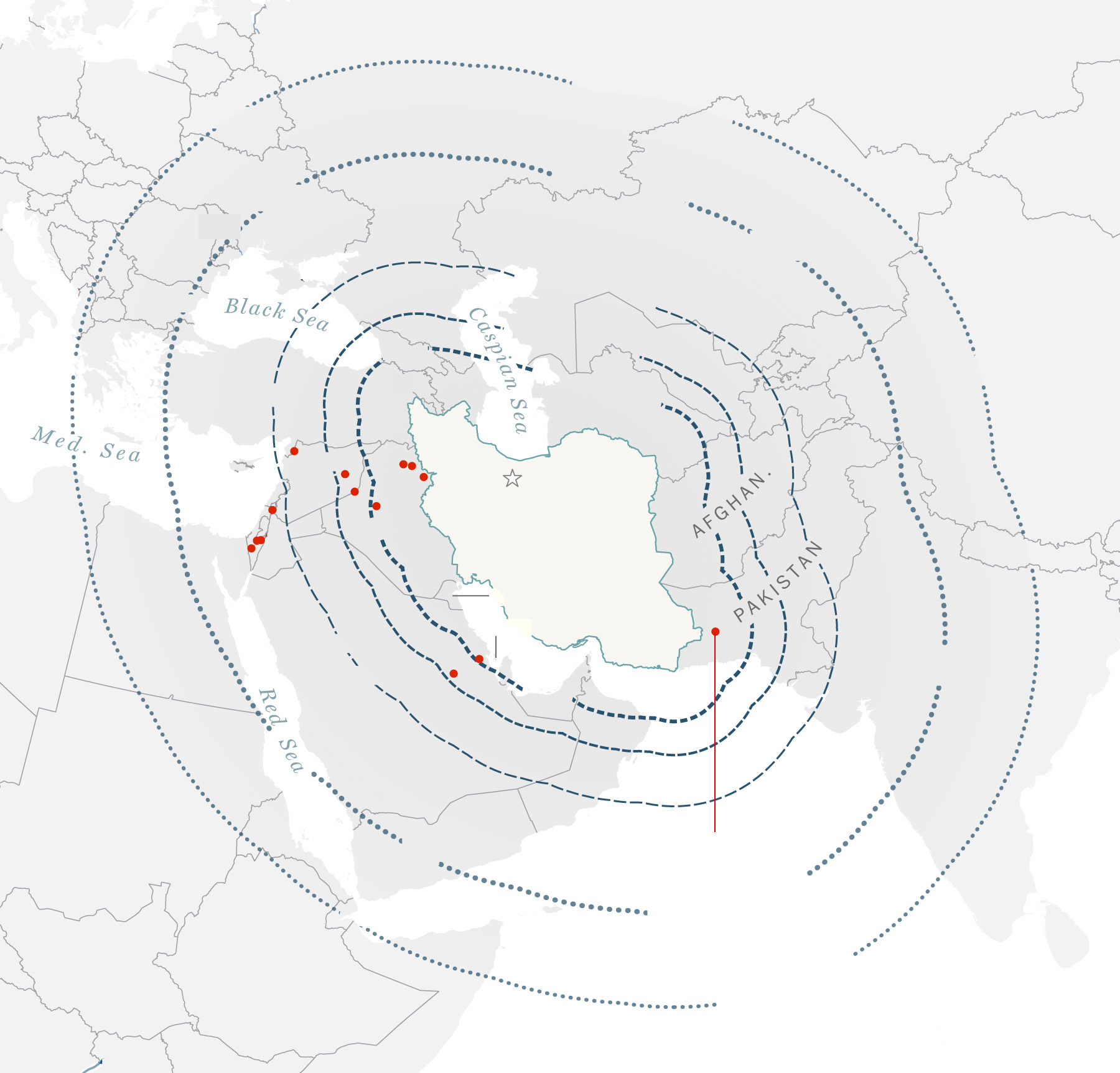
Iranian ballistic
missile ranges
1,240 miles
Locations of Iranian
missile strikes
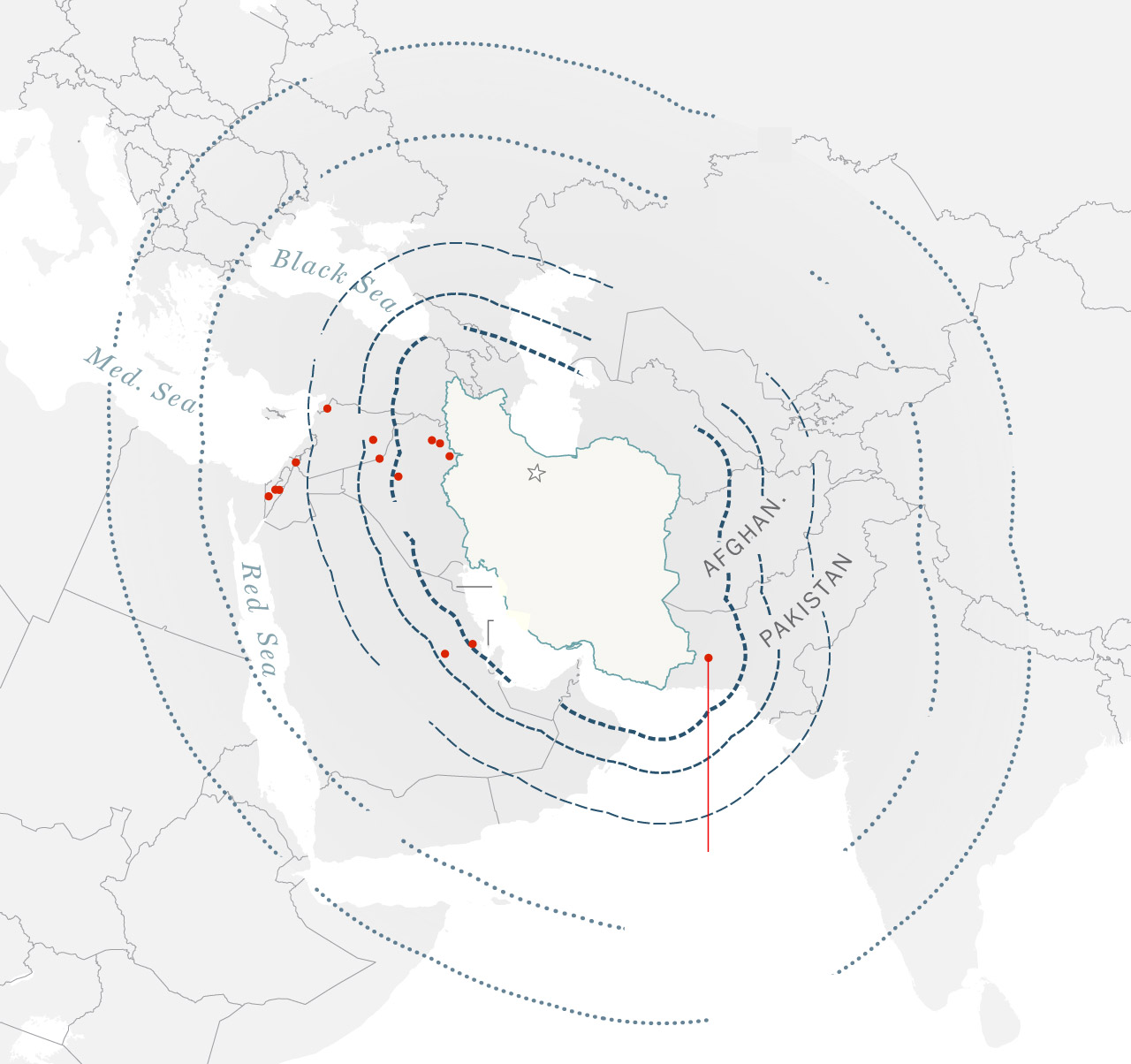
INDIAN OCEAN

But the attack on Israel suggests that many of Iran’s munitions are of low quality. Israel’s military said 99 percent of the missiles and drones launched by Iran were intercepted or failed to launch.
“We saw that accuracy and precision are a work in progress,” said Behnam Ben Taleblu, a senior fellow at the Foundation for Defense of Democracies who has written extensively about Iran’s missile program. “These weapons alone won’t win a war for Iran.”
Iranian drones made up the first wave of the attack. Cheap, effective and easy to produce, Iranian drones have been used in attacks across the Middle East for years. Iran has also supplied drones to Russia for its war in Ukraine , where they have been deadly.
During the attack on Israel, the slow-moving drones were probably deployed to occupy air defenses and allow more advanced munitions to get through. All the drones were shot down before entering Israeli airspace, the Israel Defense Forces said.
Ali Hamie, a Lebanese military analyst, said Iran had probably gleaned important lessons about Israel’s aerial defenses. Commentators on Iranian state television have made similar points.
“It could be a testing attack,” Hamie said, “and the Iranians got what they want. Making it past the air defenses is not only a symbolic victory, but real victory.”
One of the few missiles to make it through the interceptors hit an Israeli air base in the Negev desert. Images of the strike were run on loop on many state-run Iranian broadcasters in the days after the attack. Israel characterized the damage as minor.
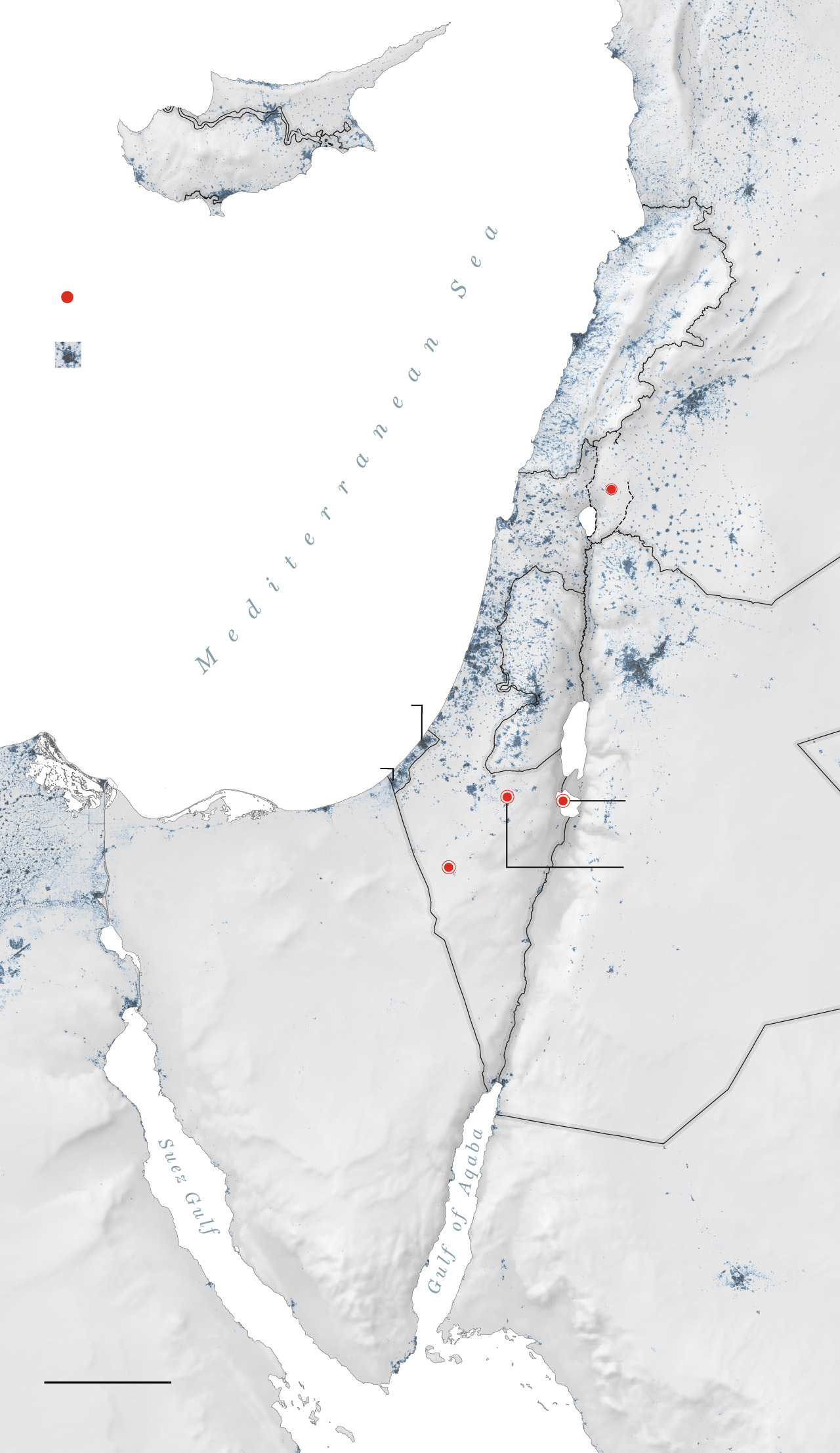
General location of missile strikes
that reached the ground.
Beirut—
Populated areas
Haifa—
Tel Aviv—
—Amman
—Jerusalem
An emad missile
was found here.
The barrage of
missiles from Iran
included targeting
the Nevatim

General location of
missile strikes that
reached the ground.
Mediterranean

General location of missile
strikes that reached the
In addition to analyzing Israel’s air defenses, Tehran will probably also be studying the problems with its missile systems that reportedly led to failures at launch and in flight, according to Afshon Ostovar, a professor of national security affairs at the Naval Postgraduate School in California.
“Another attack could be more effective,” he said. But ultimately the kind of approach demonstrated in Saturday’s attack “is not really sustainable over a long-term conflict.”
Even if Iran changed the tempo of attacks and adjusted the munitions used, “they would still have to launch quite a lot of stuff for just a few [munitions] to get through,” he said.
Some Iranian officials have suggested they have held back their most dangerous weapons.
“We are prepared to use weapons we have never used before. We have plans for every scenario,” said Abolfazl Amoui, a parliamentary national security spokesman, in an interview with Lebanese broadcaster Mayadeen.
But analysts say it’s unlikely that any one type of munition could be a game changer. Rather, it’s more likely Iran would use the same kinds of munitions in a future attack, but in a different way: giving less warning, or launching the barrage in concert with allied militant groups in the region. The country’s proxy forces, from Lebanon to Iraq to Yemen, played little role in Saturday’s assault.
As Israel mulls its response , Tehran has warned that a counterattack would come in “a matter of seconds.”
“Iran will not wait for another 12 days to respond,” Deputy Foreign Minister Ali Bagheri Kani said Monday.
While the United States and Israel have celebrated the thwarting of Saturday’s attack, analysts are urging humility.
“The number of munitions it took to repel the attack was enormous, costly and could be difficult to replicate,” said Tom Karako, the director of the Missile Defense Project at the Center for Strategic and International Studies.
“Israel may have gotten lucky and Iran may have gotten very unlucky.”
William Neff and Suzan Haidamous contributed to this report.
Israel-Gaza war
The Israel-Gaza war has gone on for six months, and tensions have spilled into the surrounding region .
The war: On Oct. 7, Hamas militants launched an unprecedented cross-border attack on Israel that included the taking of civilian hostages at a music festival . (See photos and videos of how the deadly assault unfolded ). Israel declared war on Hamas in response, launching a ground invasion that fueled the biggest displacement in the region since Israel’s creation in 1948 .
Gaza crisis: In the Gaza Strip, Israel has waged one of this century’s most destructive wars , killing tens of thousands and plunging at least half of the population into “ famine-like conditions. ” For months, Israel has resisted pressure from Western allies to allow more humanitarian aid into the enclave .
U.S. involvement: Despite tensions between Israeli Prime Minister Benjamin Netanyahu and some U.S. politicians , including President Biden, the United States supports Israel with weapons , funds aid packages , and has vetoed or abstained from the United Nations’ cease-fire resolutions.
History: The roots of the Israeli-Palestinian conflict and mistrust are deep and complex, predating the establishment of the state of Israel in 1948 . Read more on the history of the Gaza Strip .
- After Israeli strike in Iran, both sides appear to downplay incident April 19, 2024 After Israeli strike in Iran, both sides appear to downplay incident April 19, 2024
- Homes burned, animals killed: Palestinians describe Israeli settler rampage April 16, 2024 Homes burned, animals killed: Palestinians describe Israeli settler rampage April 16, 2024
- Six months of the Israel-Gaza war: A timeline of key moments April 7, 2024 Six months of the Israel-Gaza war: A timeline of key moments April 7, 2024


US sends land-attack missile system to Philippines for exercises in apparent message to China
China has accused the United States of “stoking military confrontation” with the recent deployment of a powerful missile launcher capable of firing weapons with a range of up to 1,600 kilometers to exercises in the Philippines.
The US Army’s Mid-Range Capability (MRC) ground-based missile system arrives in a region on edge following a series of dangerous Chinese-Philippine face-offs in the South China Sea, during which Philippine ships have been targeted with water cannons, injuring several Filipino sailors.
It’s the first-ever deployment of the MRC missile system, also known as the Typhon system, to the Indo-Pacific theater, and it comes amid a series of US-Philippine military exercises, including the largest-ever edition of the annual bilateral Balikatan drills beginning Monday.
The US Army has not said how long the Typhon system will remain in the Philippines, but its involvement in the series of joint exercises between the two treaty allies, the first of which began on April 8, sends a signal the US can put offensive weaponry well within striking distance of Chinese installations in the South China Sea, the southern Chinese mainland and along the Taiwan Strait, analysts say.
The Typhon system is capable of firing the Standard Missile 6 (SM-6), a ballistic missile defense munition that can also target ships at sea at a range of 370 kilometers (230 miles), according to the Missile Defense Project at the Center for Strategic and International Studies (CSIS).
It also can fire the Tomahawk Land Attack Missile, a maneuverable cruise missile with a range of 1,600 kilometers (1,000 miles), according to the CSIS.
According to Beijing its presence in the region increases the risks of “misjudgment and miscalculation.”
During a regular news briefing last week, China’s Foreign Ministry spokesperson Lin Jian accused the US of seeking a “unilateral military advantage,” and underscored Beijing’s strong opposition to the deployment.
“We urge the US to earnestly respect other countries’ security concerns, stop stoking military confrontation, stop undermining peace and stability in the region, and take concrete actions to reduce strategic risks,” Lin said.
The US Army is calling the deployment, which began April 11 for the Salaknib exercise, a “landmark” in its regional capability.
Diplomatic fallout
The apparent diplomatic fallout comes as attendees from 29 countries, including the commander of the US Pacific Fleet, attend a two-day Western Pacific Naval Symposium, which began in the eastern Chinese port city of Qingdao on Sunday.
The attendees will discuss “maritime peace, maritime order based on maritime security cooperation and international laws, and global maritime governance,” according to Chinese state-run Xinhua news agency.
Those are the same rules Washington and Manila accuse Beijing of ignoring with aggressive Chinese actions that have injured Filipino sailors and damaged vessels around disputed features in the South China Sea.
The 1951 mutual defense treaty between the US and the Philippines – the oldest such US pact in Asia-Pacific – stipulates both sides would help defend each other if either were attacked by a third party.
In brief comments to CNN on the sidelines of the gathering, US Adm. Stephen Koehler said: “I think it’s a great opportunity for all navies to get together and discuss all the issues.”
China’s missile advantage
Analysts say the deployment of the Typhon missile battery is the first signal of US plans to address what has long been an advantage for Beijing in the region.
“This in some way ‘equalizes’ the prior situation where (Chinese) missiles have threatened US forces along the First Island Chain (which includes the northern Philippines, Japan and Taiwan), and even further eastward along the Second Island Chain centering on Guam,” said Collin Koh, research fellow at the S. Rajaratnam School of International Studies in Singapore.
A 2021 report for the US Army’s professional journal Military Review puts the current missile advantage of the People’s Liberation Army Rocket Force (PLARF) in stark terms.
“The conventional arm of the PLARF is the largest ground-based missile force in the world, with over 2,200 conventionally armed ballistic and cruise missiles and with enough antiship missiles to attack every US surface combatant vessel in the South China Sea with enough firepower to overcome each ship’s missile defense,” Army Maj. Christopher Milhal wrote.
While the Typhon can’t bring those kinds of numbers into play for US forces, its mobility represents a problem for Chinese mission planners — giving it important deterrent value, analysts say.
In announcing the Typhon deployment, the US military noted how the system was delivered to the Philippines via an 8,000-mile, 15-hour flight from Washington state by a US Air Force C-17 cargo jet.
Analysts don’t expect the Typhon system to be permanently based in the Philippines, but Koh said the ability to move the batteries to a range of “pre-surveyed launch sites” around the region on short notice increases their survivability and challenges relatively new and untested Chinese intelligence, surveillance, reconnaissance (ISR) and targeting capabilities.
Whether the Typhon’s likely temporary status mitigates the fallout remains unknown. but China has previously reacted furiously to missile deployments in what it sees as its backyard.
Writing in the International Institute for Strategic Studies’ Military Balance Blog, analyst Rupert Schulenberg noted that in 2016, when South Korea agreed to the deployment of a THAAD defensive missile system on the Korean Peninsula, “Beijing responded with an unofficial economic boycott that cost South Korea’s economy $7.5 billion in 2017 alone.”
The current deployment of the Typhon was something that would not have even been an option for the US military until 2019. Development of ground-launched missile systems of the type were banned under the 1987 Intermediate Range Nuclear Forces Treaty between the US and the Soviet Union.
But the US formally withdrew from the treaty in 2019, with then-President Donald Trump “citing Russian noncompliance and concerns about China’s intermediate-range missile arsenal.”
Balikatan exercises begin
Meanwhile, the US and the Philippines kicked-off the largest of their series of joint exercises Monday, with the three-week Balikatan drills — Tagalog for shoulder-to-shoulder — involving thousands of military personnel.
A report from the official Philippine News Agency said Manila would use the annual exercises to showcase its military’s most advanced systems, including a missile frigate, light fighter jets, close-combat support aircraft and Black Hawk helicopters.
Philippine officials previously indicated the naval portion of the exercise would for the first time extend beyond the 12-nautical-mile limit of Philippine waters — and into the country’s exclusive economic zone, some 200 nautical miles (370 kilometers) from Philippine shores, though no exact route has been provided.
It will also include French naval participation in a group sail from Palawan Island, according to Philippine officials.
Palawan, which sits between the South China Sea and the Sulu Sea, is about 200 kilometers from Second Thomas Shoal, a contested feature in the Spratly Islands that has been the site of numerous face-offs between Philippine and Chinese coast guard vessels.
This story has been updated.
CNN’s Steven Jiang in Qingdao contributed to this report.
For more CNN news and newsletters create an account at CNN.com
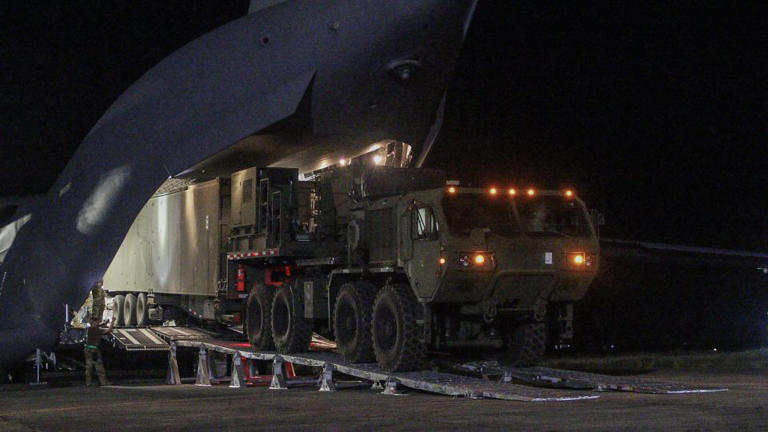

COMMENTS
Type 12 Surface-to-Ship Missile. The Type 12 Surface-to-Ship Missile (12式地対艦誘導弾) is a truck-mounted anti-ship missile developed by Japan's Mitsubishi Heavy Industries in 2012. It is an upgrade of the Type 88 Surface-to-Ship Missile. The Type 12 features INS with mid-course GPS guidance and better precision due to enhanced Terrain ...
Type 12 SSM (Upgraded) The Defense White Paper released at the end of July 2022 offers our very first look at the missile. The photo provided by Mitsubishi Heavy Industries, the manufacturer of the Type 12 SSM, shows a missile shaped like an AGM-158 JASSM. The Type 12 SSM originally had a range of about 200 km.
Each Type 12 launcher carries six missiles weighing 1,500 pounds that cruise towards the general position of a targeted vessel using a combination of inertia, GPS, and terrain-contour mapping for ...
The first contract is for mass production of the extended-range version of the domestically developed Type 12 land-to-ship cruise missiles (worth about 173.4 billion yen). The second is for the ...
The government says contracts include enhanced versions of Mitsubishi's Type 12 missiles and a hypersonic ballistic missile. ... 400 American-made long-range Tomahawk cruise missiles capable of ...
On December 18, 2020, the Japanese government decided to extend the range of Type 12 surface-to-ship missiles (SSM) manufactured by Mitsubishi Heavy Industries. What's more: The missile could be modified into an air-launched variant for the F-15J fighters. Yoshihiro Inaba 21 Jan 2021. Originally, an extended-range version of the Type 12 SSM was ...
About Type 12 Missiles. Developed in 2012, the Type 12 anti-ship cruise missile is mounted on an eight-wheel truck. The missile is an upgrade of the Type 88 surface-to-ship missile with a battery consisting of four ammunition carriers, four launch vehicles, two radar vehicles, and two trucks with communication systems and fire control.
Japan is upgrading its Type 12 surface-to-ship missile (SSM) systems to enhance its stand-off defence capabilities. A spokesperson from Japan's Acquisition, Technology & Logistics Agency (ATLA ...
The Type 12 surface-to-ship guided missile is designed to be fired from a ground-based vehicle toward an enemy vessel. It currently has a range of about 200 kilometers.
Part of Tokyo's Defense Buildup Program, these long-range "counterstrike capabilities," which will include new variants of the Type-12 anti-ship missile, hypersonic weapons and cruise ...
Type 12 Anti-ship missile. ... $1.58 billion to procure Tomahawk cruise missiles to be launched from vertical launch systems and $828 million for the relevant equipment in relation to it for ...
Japan has signed a deal with the United States to purchase up to 400 Tomahawk cruise missiles as part of its ongoing military buildup in response to increased regional threats. ... Minister Minoru Kihara announced in December a decision to accelerate deployment of some Tomahawks and Japanese-made Type 12 surface-to-ship missiles beginning in ...
Japan's Ministry of Defense has expedited the planned deployment of an improved version of the SSM-2 anti-ship missile for the Type 12 system, designed to extend its range and bolster its capabilities to strike adversary missile launch sites. According to Japanese public broadcaster NHK, initially planned for deployment in the fiscal year 2026, the implementation
The Japanese Ministry of Defense is currently in the process of extending the range of the domestically made Type 12 surface-to-ship missiles deployed by the Ground Self-Defense Force, from the ...
Under the government's plan, the unit will be armed with U.S.-made Tomahawk cruise missiles, Japan-made Type 12 surface-to-ship guided missiles, which are currently being upgraded, and ...
This is in addition to the upgraded indigenous Type 12 missile and high-speed glide missiles. Tokyo is also considering the acquisition of US Tomahawk long-range cruise missiles , factoring in the possible delay in the induction of the Type 12s by 2026.
Essentially, the Japanese Ground Self-Defense Force or Group JGSDF operates the Type 12 anti-ship cruise missile on eight-wheel trucks. In addition, a Type 12 battery usually comprises four ...
On the 2nd of August, Japanese outlet Mainichi Shimbun reported the Japanese government's intent to accelerate the enhancement programme of the Type 12 truck-launched anti-ship missile. Pushing forward the deployment timetable from first deliveries in Financial Year 2026 to equipping units with prototypes earlier in an attempt to improve defense capabilities against the rising power of China.
The Type 12 Surface-to-Ship Missile (12式地対艦誘導弾) is a truck-mounted anti-ship missile developed by Japan's Mitsubishi Heavy Industries in 2012. It is an upgrade of the Type 88 Surface-to-Ship Missile. The Type 12 features INS with mid-course GPS guidance and better precision due to enhanced Terrain Contour Matching and target discrimination capabilities. The weapon is networked ...
Defense industry news site Janes reported that the updgraded Type 12 will have a range of ... Kishida said in February the country planned to buy as many as 400 Tomahawk cruise missiles from the ...
A BGM-109 Tomahawk flying in November 2002. A cruise missile is an unmanned self-propelled guided vehicle that sustains flight through aerodynamic lift for most of its flight path and whose primary mission is to place an ordnance or special payload on a target. Cruise missiles are designed to deliver a large warhead over long distances with high precision.
The country is considering an improved version of the domestically-produced Type 12 surface-to-ship guided missile and the Raytheon Tomahawk cruise missile for the purpose. The upgraded Type 12 is expected to have a range of 750 miles (1,207 kilometers), while the Tomahawk has a range of 1,000 miles (1,609 kilometers). The missiles will be ...
The French naval cruise missile is powered by Safran's Microturbo TR 50 engine, and has a speed of around 1,000 kilometers per hour and a range of about 1,000 kilometers, according to official ...
Little is known about Israel's Jericho missiles. ... "They have submarine-launched cruise missiles and ballistic missiles which they almost certainly use for their nuclear deterrent," says Mr Hinz.
North Korea said Saturday it tested a "super-large" cruise missile warhead and a new anti-aircraft missile in a western coastal area as it expands military capabilities in the face of deepening tensions with the United States and South Korea. (AP Photo/Ahn Young-joon)
The U.S. shipment follows a similar move by the U.K., which first sent its long-range Storm Shadow cruise missiles to Ukraine in May 2023, giving Kyiv the ability to hit targets up to 155 miles away.
North Korea had conducted a power test of a super-large warhead designed for "Hwasal-1 Ra-3" strategic cruise missile and a test launch of "Pyoljji-1-2" new-type anti-aircraft missile on Friday ...
Iran's first direct attack on Israel demonstrated the advances of its domestic weapons program, analysts said, while also exposing the limits of its arsenal.
It also can fire the Tomahawk Land Attack Missile, a maneuverable cruise missile with a range of 1,600 kilometers (1,000 miles), according to the CSIS. ... missile systems of the type were banned ...